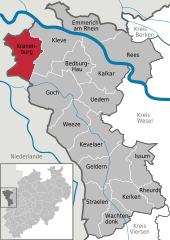Kranenburg | |
|---|---|
 | |
Location of Kranenburg within Kleve district  | |
| Coordinates: 51°47′23″N 6°0′26″E / 51.78972°N 6.00722°E | |
| Country | Germany |
| State | North Rhine-Westphalia |
| Admin. region | Düsseldorf |
| District | Kleve |
| Subdivisions | 9 |
| Government | |
| • Mayor (2020–25) | Ferdi Böhmer[1] (CDU) |
| Area | |
| • Total | 76.96 km2 (29.71 sq mi) |
| Elevation | 21 m (69 ft) |
| Population (2023-12-31)[2] | |
| • Total | 11,380 |
| • Density | 150/km2 (380/sq mi) |
| Time zone | UTC+01:00 (CET) |
| • Summer (DST) | UTC+02:00 (CEST) |
| Postal codes | 47559 |
| Dialling codes | 0 28 26 und 0 28 21 |
| Vehicle registration | KLE |
| Website | www.kranenburg.de |
Kranenburg is a municipality in the district of Cleves in the state of North Rhine-Westphalia, Germany. It is located near the border with the Netherlands, 12 kilometres (7 mi) south-east of Nijmegen and 11 kilometres (7 mi) west of Cleves.
Since 1992, Kranenburg has evolved into a commuter town for Nijmegen.[citation needed]
The village has always focused on the Dutch city of Nijmegen, and the local language was Dutch until far into the 19th century.[citation needed]
- ^ Wahlergebnisse in NRW Kommunalwahlen 2020, Land Nordrhein-Westfalen, accessed 21 June 2021.
- ^ "Bevölkerung der Gemeinden Nordrhein-Westfalens am 31. Dezember 2023 – Fortschreibung des Bevölkerungsstandes auf Basis des Zensus vom 9. Mai 2011" (in German). Landesbetrieb Information und Technik NRW. Retrieved 20 June 2024.


